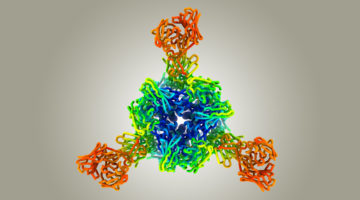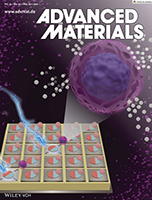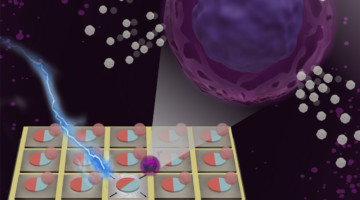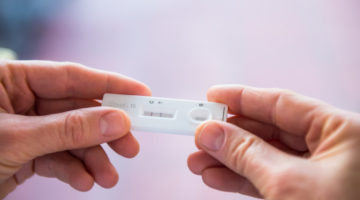Early in the COVID-19 pandemic, it was quickly established that the receptor binding domain (RBD) of the SARS-CoV-2 spike protein is a prime target for neutralizing antibodies. Now, scientists have found a second region of the spike protein that is targeted by dozens of antibodies, some of which exhibit ultrapotent neutralizing activity. Read more »
Conformational Dynamics in the Interaction of SARS-CoV-2 Papain-like Protease with Human Interferon-Stimulated Gene 15 Protein
The image depicts the complex formed between SARS-CoV-2 papain-like protease and human interferon-stimulated gene 15 protein. Small-angle scattering elucidated the structural details of this complex providing insight into its role in suppressing the innate immune response and also potential routes for development of therapeutics to combat COVID-19. Read more »
Structure of blood coagulation factor VIII in complex with an anti–C1 domain pathogenic antibody inhibitor
van der Waals sphere representation of the factor VIII C1 domain, highlighting surface‐exposed hemophilia A–associated mutations that cause impaired von Willebrand factor binding and overlap with a pathogenic anti‐C1 domain inhibitor epitope. Read more »
Guiding Target Selection for COVID-19 Antibody Therapeutics
Protein-structure studies helped demonstrate that the primary target of antibody-based COVID-19 immunity is the part of the virus’s spike protein that can most easily mutate. The work anticipated the rise of SARS-CoV-2 variants and guides the selection of antibody therapeutics that are likely to be more resistant to immune escape. Read more »![]()
![]()
Single-Domain Multiferroic Array-Addressable Terfenol-D (SMArT) Micromagnets for Programmable Single-Cell Capture and Release
Researchers develop programmable multiferroic micromotors that enable single-cell manipulation based on time-dependent functions of individual cells, such as cell secretion. Smart programmable multiferroic materials lay the groundwork for large-scale automated single-cell sorting and enable a broad spectrum of biotechnology applications. Read more »
Programmable Micromagnets for Single-Cell Sorting
Researchers demonstrated that electrically induced mechanical strain can control the magnetic state of tiny magnets used to sort biological cells. The work lays the foundation for a programmable, single-cell sorting platform to support a wide variety of biotechnology applications, including personalized cancer treatments. Read more »![]()
![]()
How X-Rays Could Make Reliable, Rapid COVID-19 Tests a Reality
A highly sensitive lateral flow assay—the same type of device used in home pregnancy tests—could be developed using pairs of rigid antibodies that bind to the SARS-CoV-2 nucleocapsid protein. SAXS data showed that a particular pair of monoclonal antibodies bound to the nucleocapsid protein very strongly and stably, in part due to the antibodies’ rigidity. Read more »
Structure-Based Design of Selective LONP1 Inhibitors for Probing In Vitro Biology
LONP1 is an AAA+ protease that maintains mitochondrial homeostasis by removing damaged or misfolded proteins. Elevated activity and expression promotes cancer cell proliferation and resistance to apoptosis-inducing reagents. Herein, we report the development of selective boronic acid-based LONP1 inhibitors using structure-based drug design as well as the first structures of human LONP1 bound to various inhibitors. Read more »
Targeting KRAS Mutant Cancers via Combination Treatment: Discovery of a 5-Fluoro-4-(3H)-quinazolinone Aryl Urea pan-RAF Kinase Inhibitor
The cover feature shows a chessboard (representative of KRAS mutant cells) and how the concerted action of the MEK inhibitor cobimetinib (rook) and the new selective pan-RAF inhibitor GNE-0749 (queen) force the opposing king (phospho-ERK, the downstream signaling node of RAF and MEK) into checkmate. Read more »
Mystery Protein Helps COVID–19 Avoid Immunity
Using the Advanced Light Source (ALS), researchers solved the structure of ORF8, a protein specific to SARS-CoV-2. Understanding the structure of ORF8 opens the door to therapy studies targeting SARS-CoV-2, the virus responsible for causing COVID-19. Read more »![]()
![]()
- « Previous Page
- 1
- …
- 6
- 7
- 8
- 9
- 10
- …
- 24
- Next Page »









